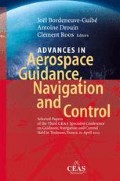Abstract
This paper presents a sensitivity study of a wake vortex impact alleviation system based on an airborne forward-looking Doppler LiDAR sensor. The basic principle of the system is to use this sensor to measure the wind remotely ahead of the aircraft. On the basis of these measurements the system estimates whether a wake vortex is located in front of the aircraft. If this is the case, the wake vortex characteristics are identified and the control deflections countervailing the wake-induced aircraft response are computed and applied. An integrated simulation environment comprising a full nonlinear 6-DoF A320 model (with control laws), wake vortex models, and the wake impact alleviation algorithms was developed. The LiDAR sensor subsystem has many design parameters that influence the overall performance in a complex way, which makes it difficult to derive adequate requirements. The presented parameter study provides first insights into the role of each parameter as well as some adequate parameter combinations.
Access this chapter
Tax calculation will be finalised at checkout
Purchases are for personal use only
Preview
Unable to display preview. Download preview PDF.
References
TSB, Encounter with Wake Turbulence Air Canada Airbus A319-114 C-GBHZ Washington State, USA 10 January 2008, Aviation Investigation Report A08W0007 (April 8, 2010)
NTSB, Brief of Accident LAX99LA291, Washington, D.C. (May 17, 2001)
ATSB, Wake turbulence event Sydney Airport, NSW 3 November 2008, Aviation Occurrence Investigation AO-2008-077 (November 2009) ISBN 978-1-74251-009-5.
NTSB, In-Flight Separation of Vertical Stabilizer American Airlines Flight 587 Airbus Industrie A300-605R, N14053 Belle Harbor, New York November 12, 2001, NTSB/AAR-04/04, Washington, D.C. (2004)
NTSB, Brief of Accident LAX94FA073, Washington, D.C. (October 06, 1994)
Looye, G., Lombaerts, T., Kier, T.: Design and Flight Testing of Feedback Control Laws. Research Report DLR-FB-2012-02, The DLR Project Wetter & Fliegen, p. 162-170 (2012)
Rafi, M., Steck, J.: Response and Recovery of an MRAC Advanced Flight Control System to Wake Vortex Encounters. In: AIAA Infotech@ Aerospace Conference, Boston (August 2013)
Schwarz, C., Hahn, K.-U.: Automated Pilot Assistance for Wake Vortex Encounters. In: CEAS, Berlin, Germany, September 10-13 (2006)
Hahn, K.-U., Fischenberg, D., Niedermeier, D., Horn, C.: Wake Encounter Flight Control Assistance Based on Forward-Looking Measurement Processing. In: AIAA Guidance, Navigation, and Control Conference, Toronto, Ontario Canada, August 2-5 (2010)
Kloidt, S.: Beiträge zum Entwurf eines Flugregelungssystems zur Reduktion des Wirbelschleppeneinflusses (English: Contributions to the Design of a Flight Control System for the Reduction of the Wake Vortex Impact). Ph.D Thesis, TU Berlin, Germany (2007)
Ehlers, J., Fischenberg, D., Niedermeier, D.: Wake Identification Based Wake Impact Alleviation Control. In: AIAA AVIATION, Atlanta, GA, US, June 16-20 (2014)
Fischenberg, D.: Online Wake Identification Algorithms Using Forward Looking LIDAR Sensor Measurements. DLR Report IB111-2013/11, DLR German Aerospace Center, Braunschweig, Germany (February 2013)
Fischenberg, D.: Strömungsermittlungsverfahren/Flow Determination Method/Procédé de détermination d’écoulement. Patent No. EP 2 340 438 B1, European Patent Office (2013)
Jategaonkar, R.V.: Flight Vehicle System Identification: A Time Domain Methodology. Progress in Astronautics and Aeronautics. AIAA, Reston (2006)
Burnham, D.C., Hallock, J.N.: Chicago Monoacoustic Vortex Sensing System. Wale Vortex Decay, vol. 4. National Information Service, Springfield (1982)
Fischenberg, D.: A method to validate wake vortex encounter models from flight test data. In: 27th International Congress of the Aeronautical Sciences, ICAS 2010, Nice, France (2010)
Author information
Authors and Affiliations
Corresponding author
Editor information
Editors and Affiliations
Rights and permissions
Copyright information
© 2015 Springer International Publishing Switzerland
About this paper
Cite this paper
Ehlers, J., Fezans, N. (2015). Airborne Doppler LiDAR Sensor Parameter Analysis for Wake Vortex Impact Alleviation Purposes. In: Bordeneuve-Guibé, J., Drouin, A., Roos, C. (eds) Advances in Aerospace Guidance, Navigation and Control. Springer, Cham. https://doi.org/10.1007/978-3-319-17518-8_25
Download citation
DOI: https://doi.org/10.1007/978-3-319-17518-8_25
Publisher Name: Springer, Cham
Print ISBN: 978-3-319-17517-1
Online ISBN: 978-3-319-17518-8
eBook Packages: EngineeringEngineering (R0)

